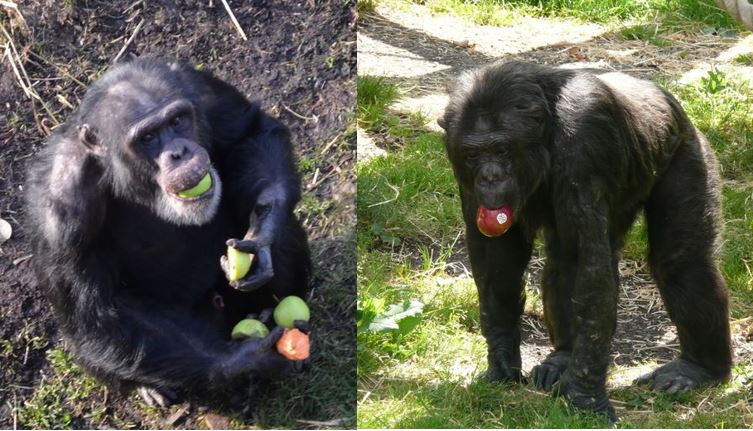Chimpanzees have specific words (grunts) for different types of fruit, and after some time, can adopt a different language with novel sounds after joining a new community of chimps.
A community of chimps in Edinburgh Zoo had a specific grunt for “apple”, while another community at Beekse Bergen Safari Park in the Netherlands had a different grunt for the same fruit. Three years after some of the Dutch chimpanzees had joined the Scottish community, the sound of their grunt for apple had changed to that of their new group.
In other words, when two communities collide, chimpanzees “converge” their utterances. (Listen to the four sound recordings at the bottom of this page)
Researchers from the Universities of York in England and Zurich in Switzerland say their study is the first to provide evidence that chimps can “learn” calls that refer to specific objects.

Paul (left), Beekse Bergen group. (Photo credit: Emma K Wallace). Emma, Edinburgh group. (Photo credit: Jamie Norris)
Chimps’ grunts have specific meanings
Chimpanzees utter distinct sounds in the form of grunts when they find certain types of foods, and their peers understand what those grunts mean.
Scientists have previously assumed that chimps had little control over the structure of their calls. They thought that the structure of their calls was a read-out of arousal, i.e. utterances produced out of general excitement or preference for the food.
In this study, which was published in the peer-reviewed academic journal Current Biology (citation below), the investigators had a unique opportunity to see whether chimps could change the structure of their food calls when some adult chimpanzees from the Netherlands were integrated with the resident chimps at Edinburgh Zoo in 2010.
Before integration, the researchers noted that the animals in each community had a different grunt for apples – they spoke different languages. They also found that their preferences for apples were not the same.
New “apple” grunt adopted after three years
Within three years of integration, the ‘new’ chimps had changed their grunt-sound for apple, i.e. they had adopted the other group’s language.
Biologists and animal psychologists have always said that non-human primates can produce vocalizations, such as food or alarm calls, that refer to external objects in the environment. They have also assumed that the animals’ acoustic structure is fixed and a product of arousal state.
Some researchers have argued that non-human primates’ seeming lack of flexible control over the sounds they utter demonstrates that they do not possess “language”.
However, Dr. Katie Slocombe, of the Department of Psychology at the University of York, and colleagues have challenged this long-standing assumption. They say captive chimps had “learned” grunts that referred to specific foods.
And furthermore, chimps also have the ability to adapt the structure of their meaningful grunts, over time, to the sounds uttered by those in their new community.
The researchers recorded the Dutch chimps’ “apple” grunts, before integration in 2010, then again in 2011 (after integration), and finally in 2013.
Call structures converge after strong friendships are established
Dr. Slocombe and team reported that just one year after integration the new residents had not changed the sound of their “apple” grunt – it wasn’t until 2013 “when social network analyses indicated strong friendships were established between members of the original subgroups, that the call structures converged.”
“An extraordinary feature of human language is our ability to reference external objects and events with socially learned symbols, or words. These data represent the first evidence of non-human animals actively modifying and socially learning the structure of a meaningful referential vocalization.”
“Our findings indicate that primate referential call structure is not simply determined by arousal, and that the socially learnt nature of referential words in humans is likely to have ancient evolutionary origins.”
Dr. Simon Townsend, who works in the department of Evolutionary Biology & Environmental Science at the University of Zurich, added:
“These findings might shed some light on the evolutionary origins of these abilities. The fact that both humans and now chimpanzees possess this basic ability suggests that our shared common ancestor living over 6 million years ago may also have been socially learning referential vocalizations.”
Citation: “Vocal Learning in the Functionally Referential Food Grunts of Chimpanzees,” Stuart K. Watson, Simon W. Townsend, Anne M. Schel, Claudia Wilke, Emma K. Wallace, Leveda Cheng, Victoria West, Katie E. Slocombe. Current Biology. DOI: http://dx.doi.org/10.1016/j.cub.2014.12.032.
1. In 2010, Frek (a Dutch chimp) has a very high pitched grunt.
2. In 2010, Lucy (an Edinburgh chimp), has a lower-pitched grunt.
3.In 2013, Frek’s grunt has changed and sounds more like Lucy’s.
4. In 2013, Lucy’s grunt.
Update, November 2015: A new study says the researchers’ conclusions were flawed.

